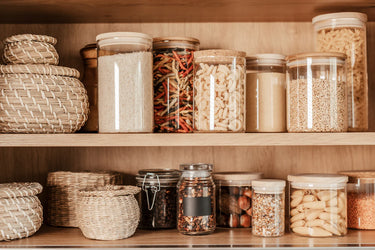How To Reset Your Pantry

It’s funny how certain areas of the kitchen get treated differently. We’d never think twice about cleaning out the fridge regularly. Those jalapeños molding in the back of the crisper drawer or the week-old takeout that never got finished should obviously go! But, when it comes to the pantry—where snacks, baking ingredients, grains, nuts and seeds, and more live—well, it can be easier to forget that it needs a regular clean out, too. Resetting your pantry isn’t difficult or time consuming. It’s a good time to assess what you eat regularly versus what overly ambitious purchases have languished in the back of the top cabinet. It’s a good time to restock and reassess.
Make a pantry reset a three-times-a-year event: at New Year’s, midway through spring, and when back-to-school rolls around (even if you’re an adult, will September ever feel like it’s not back-to-school time?). This allows you to put away seasonal ingredients: Christmas sprinkles or Fourth of July flag toothpicks can be stored for the appropriate time. And when school is back in session, making room for more snacks is a worthwhile task.
One meta tip to make resetting your pantry so much easier: Don’t pair it with other deep cleaning tasks. Tackling a deep clean of your kitchen (let alone your entire home) while also resetting the pantry can make for an overly daunting task. It doesn’t have to take more than a couple hours of focus. So, take a deep breath, assemble a snack, and get started with these helpful tips.
How to reset your pantry
- Pull everything out: Start by taking everything out of the cabinets, leaving nothing behind. Sort like with like: baking stuff should stick together, while grains, canned goods, and other cooking ingredients like spices are at home in their own groups. Stick snacks in separate area.
- Set anything that has surpassed its “best by” date: Just because something has passed the best by date doesn’t mean that it can’t be eaten. Check your country's guidelines on what’s okay to eat beyond the date stamped on the packaging.
- Clean the pantry: Vacuum and wipe down the shelves, drawers, and any bins. It’s worth putting a pantry moth trap in each cabinet to keep any eye out for these unwelcome pests—if they take root, you might have to toss hundreds of dollars of food and ingredients.
- Decant like ingredients into jars and other airtight containers: If you’ve discovered a cup of rice in one bag and 2 cups in another and so on, it can be helpful to corral them in a single jar. Repeat with any similar ingredients.
- Assess what you bought with the best of intentions: There’s the reality of home cooking and the dream of it. The two are often misaligned, resulting in food waste. If you really want to use a new ingredient, stick it on your countertop to remind you to find a recipe.
- Make a list of the staples you need to restock: Before reassembling your pantry, take note of what you’ve used often, sometimes, rarely, and never. If you have the energy, type up this list, for easy access at the supermarket. Note anything you need to stock up on.
- Consider the sticking points: Would a lazy susan make your oils and vinegars easier to reach? Do you need a tiered spice stand to make finding the coriander or herbs de Provence easier? Are there some ingredients you only use rarely (like cookie decorating ingredients) and could stick into an airtight bin at the very back of the cabinet? Ask these questions before buying something you might not use.
- Restock the pantry: If you can live with everything out on the counter for a day or two, buy what you need to replace or any organization tools first. Then, carefully put things back in their new or old homes. You might even want to move certain ingredients to the fridge or freezer to prevent their going rancid. Raw nuts and seeds, for instance, do better stored in the freezer, which can prevent their health-promoting oils from going bad.
- Add labels, if you like: If part of what’s getting in the way of your pantry’s happiness (and by extension, your happiness) is that family members put things back in the wrong places, consider labeling the jars, containers, and sections of the pantry. It’s not that they’re trying to drive you mad by putting the sugar behind the snacks or the canned tomatoes with the pasta, we swear.




